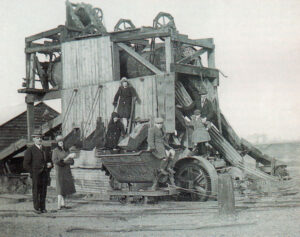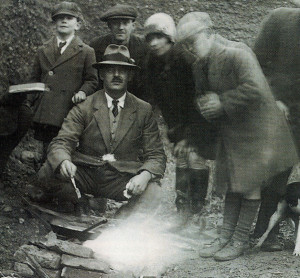
Great heavy lorries, spilling bits of sand and stone on our roads…. all that noisy machinery tearing the heart out of our countryside…”
Such criticisms are heard often today about the sand and gravel industry, particularly when some local paper carries the story that a quarry planning application “threatens a whole village.”
Yet the whole of the construction industry depends utterly upon plentiful supplies of sand, gravel and crushed rock. Houses, schools, roads and coundess other building needs, all require aggregate.
It was not, however, vital in the different world of 100 years ago although small quarries and pits had existed for centuries to help local building.
What transformed the situation was the invention of concrete. Sand and gravel (or crushed limestone or granite rock in the mountainous areas) mixed with cement became the main building material in the early 20th Century. The challenge was then on for the small concerns to grow fast enough to meet the new demand for concrete – and other building materials such as grit and roadstone and, later, tarmacadam and asphalt.
When my father used his gratuity after the First World War, he ‘took the plunge’ of buying just such a small concern – little more than a field at the time – in rural Essex.
As a result, I literally ‘grew up in a gravel pit’ during the next two decades following my birth in 1921. And what memories I have of how the tiny industry of those days began to develop into the giant business we know today.
It was all picks, shovels and crow-bars to begin with in the typical dry working, south of England sand and gravel pits. Planks and sleepers lead to a small ‘face’; the next job was to strip off adjacent top soil and crow-bar the ballast down to the floor of the ‘face’ which was then shovelled into a farm-type cart pulled away to the customer by horse.
That was very much square one! More of the ballast was soon needed; and a larger ‘face’ began to be served by jubilee trucks running on rails. Some screening was necessary, too, and laborious hand screens were soon superseded by jigger devices, powered by a small engine. Grit and larger stones were segregated from the sand and
a wider sale meant more carts and more horses.
Aged about six, I would spend hours ‘helping’ the four or five men involved doing all these operations as well as sharing their breaks and drinking cold tea just as they did. My father seemed quite happy to leave me doing this and it says a lot for the patience and kindness of his workmen that they put up with me.
My father would be out getting orders, doing book work and hunting for additional bits of equipment. He also handled a shovel pretty well himself when he thought necessary.
Sometimes, to make a change from the pit work, I would ride as ‘mate’ with the horseman in charge of horse and cart delivery to a customer. How proud I was to be allowed to pull the reins and say Whoa…there… boy!” when the horse was going too fast downhill.

How proud too, when we got back (a day’s work was four miles away and four miles back) to help unharness and groom the horse – with more cold tea to finish the day!
To make good concrete, aggregate needed to be clean, free from clay and the right size. So the next stage – which my father was on to before the 1920s ended -was to have a complete washing and screening plant.
And, again, what fun for me when our first one was installed.
A Lister locomotive towed jubilee trucks on a rail from ‘face’ to plant feed hopper, where the ballast was tipped in to start its journey up a bucket elevator to rotary screens constandy sprayed with water. The shining clean and graded stone ran out in ‘chutes’ to storage bins while the sand (in runaway water) was filtered out by revolving metal fins in great dollops the other side. The residue silt ran away to a far corner of the pit.
The whole, if I had known about Heath Robinson then, could have been exactiy described by one of his drawings. Sheer fun and fascination to watch working and, when it was not working, a better climbing frame than anything a modem leisure playground could possible devise.
The pits transport developments were the real excitement at this stage, though. Horses were retired for ever, and replaced by a gleaming Foden steam wagon and two very early Bedford lorries.
Many a ride I had on them: but the biggest thrill was when, after hours, my indulgent father allowed me to operate the Lister locomotive. I felt very close to my then hero, Sir Malcolm Campbell, who had broken the land speed record.
It was not just mechanical developments which made a gravel pit of those days a kind of wonderland. No boy who has ever played in the mountains of sand a gravel pit can accumulate will ever forget having, in effect, a private beach all to himself. And what joy, chasing, and being chased by your friends over enormous, cascading, piles of stone as well as building forts.
Even the silt, washed away into the far recesses of the pit, had its place in the wonderland. Called ‘the pug’, I would make my friends’ flesh creep by warning that if they fell into it, they “would never be seen again.”
My father’s gravel pit grew and grew. As he had always known, lowly sand and gravel had in the south of England such enormous economic advantages over crushed rock from mountains that the demand was bound to increase. His pit remained what was called a dry pit using excavators. It all meant more plant… more output.
When World War Two began, where I had played in earlier years was the scene not only of washing and grading plants of even greater refinement, but also of Tarmacadam and asphalt plants together with a weighbridge. To and fro around these manoeuvred streams of lorries, dumpers and loading shovels, rather like small animals waiting to be fed.
And the war, of course, multiplied all. How would the aerodromes, the defence installations – the Mulberry Harbour, too! – have come into being without sand and gravel?
Father’s gravel pit – like many others -became no longer a place to play in. The boy, anyway, had grown up. He, like all the boys of his generation, had gone away to the war.
The gravel pit was eventually sold some years after the war, when my father retired. I felt I could not continue it: I wanted to go into the Church.
Now, long years after, I nevertheless still look back widi affection to the little bit of Old England I knew in the 1920s and 1930s – when I grew up in a gravel pit.
I fancy I can even still taste the cold tea….
Canon William Loveless








